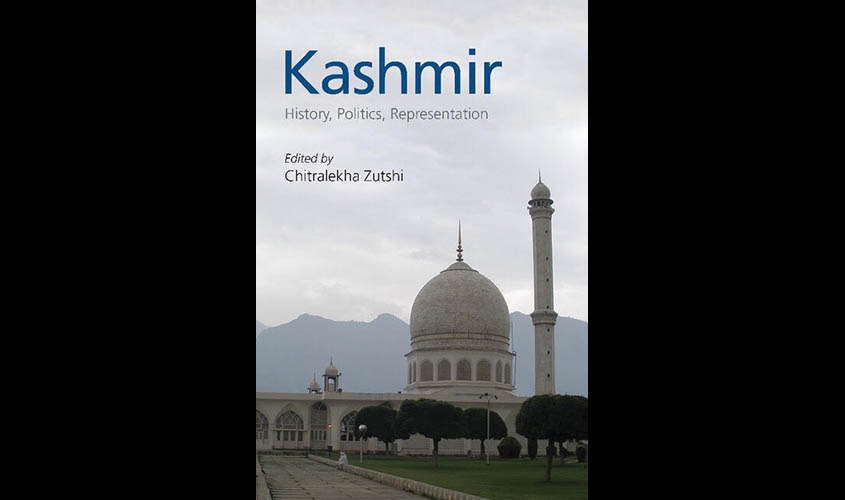The volume helps us move beyond the usual ways of thinking about Kashmir that have proven abortive.
Amidst the aggressive debates, terrible violence and atrocious human rights violations in Kashmir, some very serious scholars within the broader social sciences and humanities have been silently working for a more accurate and critical understanding of key issues to produce a more informed and serious dialogue towards resolving the crisis in Kashmir. Professor Chitralekha Zutshi of the College of William and Mary, United States, is one of the most respected historians of Kashmir in the current generation with a couple of widely appreciated books: Languages of Belonging: Islam, Regional Identity, and the Making of Kashmir (2003/2004) and Kashmir’s Contested Pasts: Narratives, Sacred Geographies, and the Historical Imagination (2014). Professor Zutshi has recently edited a fine collection of critical essays, Kashmir: History, Politics, Representation. The elegantly designed book with 14 substantial chapters will interest all stakeholders, policymakers, scholars, as well as general readers for its wide-ranging coverage of themes and ideas, especially in these times when the politics of violence has reached a dead-end.
The historians in the volume deploy an interdisciplinary approach, especially by accessing the Kashmiri language archive through ethnographic research to understand debates and questions on religion, region and nation in the past and the present, in an attempt to transcend ideological barriers that prevent a proper appreciation of Kashmir’s rich history. Similarly, the contributors on politics adopt sociological, ethnographic and literary approaches to cast a wide net on critical questions involving social and political marginalisation, besides violations of different kinds. The volume also offers fresh scholarly insights on understudied regions, such as Gilgit-Baltistan and Pakistani Kashmir, thereby broadening our understanding of the issue and region of Kashmir over a longue durée.
The short and crisp “Introduction” by the editor helps navigate the uninitiated in Kashmir’s intellectual traditions and the varied responses to conflict and violence for a better understanding of the intricacies of political and social relationships in conflict zones. There are a number of points that the individual essays make, which might be worth highlighting, since they can be useful in comparative terms for other embattled regions as well. These include thinking about these regions as more than simply zones of conflict; conflict itself as more than a battle over territory between states, but more in terms of contested narratives, gender and other identities, and political representation. The meanings of representation, moreover, go beyond the political and can be articulated in terms of who represents a place and how, and the contestations to these representations. Finally, the volume reminds us that politics even in conflict zones needs to be examined in terms of caste, class, centre-region disputes, and so on.
Together, the essays in this volume help us move beyond the usual ways of thinking about Kashmir that have proven abortive and only complicated this sensitive issue further. The communalisation of the problem, on the one hand, and linking of separatist violence with international terror-networks, on the other, have unfortunately brought the issue to its current hopeless state, which can still be resolved peacefully through sincere respect for a multiplicity of perspectives and an acknowledgment of the grievances of the region’s inhabitants.
In this context, invoking Kashmir’s own narrative and religious traditions might be helpful. As Zutshi’s earlier work as well as the edited volume illustrates, Kashmir is an amalgam of multiple influences, people, and cultures that have co-existed despite differences and at times conflict. Kashmir’s indigenous mystics, such as Nund Rishi and Lal Ded, recognised divisions along lines of class, politics, and religion, while also advocating for their redressal and accommodation, ideas that Kashmir’s narrative tradition celebrates in multiple languages—Sanskrit, Persian, Kashmiri and Urdu.
Thus, lessons from the past can help. History should be seen not in the dubious sense of imagined wrongs of thousands of years past that must be corrected and revenged depending on political need, but rather as an informed understanding of the complexities of the processes which might include conflict of interests as well as longstanding shared social and cultural practices. We cannot allow these practices to be torn asunder by political gimmicks that seek to fan sectarian prejudices. In the language of Kalhana, the famed poet-historian of Kashmir, a proper understanding of history can offer shantrasa, calm reflection and realisation in times of political abuses, cacophony and violence. Indeed, there is need to rise above the usual communal divide for much-needed sanity on the issue of Kashmir.
Based on Chitralekha Zutshi, ed., Kashmir: History, Politics, Representation, New Delhi: Cambridge University Press, 2017.

